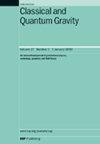Fractional Schwarzschild–Tangherlini black hole with a fractal event horizon
IF 3.6
3区 物理与天体物理
Q2 ASTRONOMY & ASTROPHYSICS
引用次数: 0
Abstract
We demonstrate that the implementation of the fractional and non-local Wheeler–DeWitt equation within the context of Schwarzschild geometry leads to the emergence of a Schwarzschild–Tangherlini black hole (BH), which is uniquely characterized by an event horizon that exhibits fractal properties and is defined by a non-integer dimension that lies in the continuum between the values of 1 and 2. Our calculations further reveal that this intriguing fractional BH may potentially possess a temperature that is substantially lower than that of a conventional BH, thereby suggesting a significant deviation from the expected thermodynamic properties of standard BHs. These remarkable characteristics, which are intrinsically linked to the non-integer dimensionality of the event horizon, likely arise from applying the Riesz fractional derivative as a sophisticated non-local operator, thus introducing fascinating dynamics into the theoretical framework of BH physics.具有分形视界的分数阶史瓦西-唐赫里尼黑洞
我们证明,在史瓦西几何背景下,分数和非局部惠勒-德维特方程的实现导致史瓦西-坦赫里尼黑洞(BH)的出现,该黑洞的独特特征是具有分形特性的事件视界,并由位于值1和2之间的连续体中的非整数维定义。我们的计算进一步揭示了这个有趣的分数黑洞可能具有比传统黑洞低得多的温度,从而表明它与标准黑洞的预期热力学性质有很大的偏差。这些显著的特征与视界的非整数维度有着内在的联系,可能源于将Riesz分数阶导数作为一个复杂的非局部算子,从而将迷人的动力学引入黑洞物理的理论框架。
本文章由计算机程序翻译,如有差异,请以英文原文为准。
求助全文
约1分钟内获得全文
求助全文
来源期刊

Classical and Quantum Gravity
物理-天文与天体物理
CiteScore
7.00
自引率
8.60%
发文量
301
审稿时长
2-4 weeks
期刊介绍:
Classical and Quantum Gravity is an established journal for physicists, mathematicians and cosmologists in the fields of gravitation and the theory of spacetime. The journal is now the acknowledged world leader in classical relativity and all areas of quantum gravity.
 求助内容:
求助内容: 应助结果提醒方式:
应助结果提醒方式:


